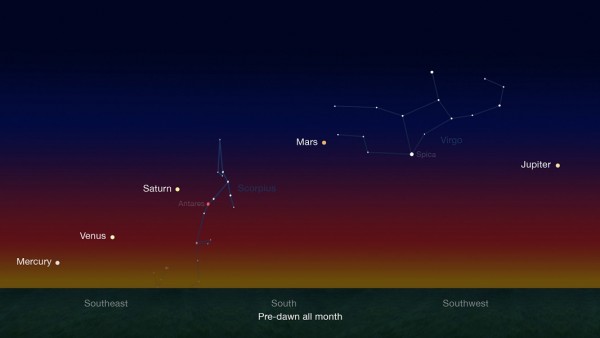By Ana Verayo, | January 31, 2016

Early risers have an opportunity to see five naked-eye planets in pre-dawn skies during late January and continuing through late February.
This week, five planets will be visible across the skies before sunrise, where Mercury, Venus, Mars, Jupiter and Saturn will grace the skies among a blanket of stars in the background. The best time to see the five planets is about 45 minutes before sunrise where they will be in equal distance from each other, spreading out across 110 degrees.
Like Us on Facebook
Jupiter will can be spotted in the southwestern sky where Mars will slowly arrive from the south, as Saturn will be arching from the southeastern region of the sky, where skywatchers can immediately spot twinkling Venus on Saturn's lower left and Mercury just below the horizon.
The five planets can be seen over the course of two weeks, as Mercury will slowly but surely climb higher and become brighter.
When morning twilight comes slowly enveloping the skies, Venus and Saturn will become more noticeable, shining in the southeastern region of the sky. Venus will appear brilliantly at a magnitude of -4.0 which is the brightest point where light can shine from the sky.
Venus appears brighter than Saturn of course but Saturn is also a mysterious and spectacular sight to see as its rings can be visible through a telescope showing a 16″-diameter disk where the incredible ringed system spans about spans 36″ and is tilting 26 degrees when viewed. Saturn shines at a magnitude of 0.5 where it can be located 15 degrees to the upper right of Venus.
Since the beginning of January, Mars is slowly becoming brighter which is shining at a magnitude of 0.8 where the Red Planet's motion is almost the same as the Sun's which means, Mars is only visible about 30 minutes earlier by the end of January than New Year's day.
Last year, Mars can rarely be seen since its diameter is not more than 5.5" however this will change this month as the planet is now significantly closer to Earth as it will now appear at 6.8" across that can even reveal its surface features with more powerful telescopes. As spring approaches, Mars will become bigger and brighter ever since 2005.
When Mercury approaches Venus, the tiny planet will stand nine degrees high in the southeastern region of the sky some 30 minutes before sunrise today where it is seven degrees on the lower left of Venus. Mercury shines with a magnitude of 0.0 that can be seen clearly via binoculars.
The moon also passed above the star known as Spica yesterday where it will approach Mars tomorrow and Saturn on February 3. The moon will also shine above Venus and Mercury of February 6.
-
Use of Coronavirus Pandemic Drones Raises Privacy Concerns: Drones Spread Fear, Local Officials Say

-
Coronavirus Hampers The Delivery Of Lockheed Martin F-35 Stealth Fighters For 2020

-
Instagram Speeds Up Plans to Add Account Memorialization Feature Due to COVID-19 Deaths

-
NASA: Perseverance Plans to Bring 'Mars Rock' to Earth in 2031

-
600 Dead And 3,000 In The Hospital as Iranians Believed Drinking High-Concentrations of Alcohol Can Cure The Coronavirus

-
600 Dead And 3,000 In The Hospital as Iranians Believed Drinking High-Concentrations of Alcohol Can Cure The Coronavirus

-
COVID-19: Doctors, Nurses Use Virtual Reality to Learn New Skills in Treating Coronavirus Patients







